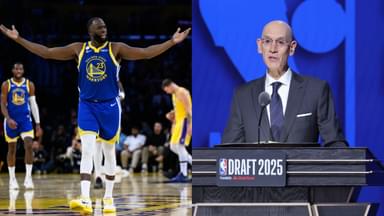An NBA commissioner is in charge of the highest-ranking office in the league. It is an arduous job that requires tremendous negotiation skills as each decision determines the direction of the League and its 30 teams. Adam Silver, the NBA commissioner since February 1, 2014, has been responsible for bringing major transformations to the league.
He is just the fifth Commissioner in the eight decades of NBA history, implying that an NBA’s commissioner tenure can last for multiple decades. Here is a look at the tenure of each NBA commissioner and some of the major changes they brought to the league.
| Name | Tenure |
| Maurice Podoloff | June 6, 1946 – April 30, 1963 (16 years and 329 days) |
| J. Walter Kennedy | May 1, 1963 – May 31, 1975 (12 years and 31 days) |
| Larry O’Brien | June 1, 1975 – January 31, 1984 (8 years and 245 days) |
| David Stern | February 1, 1984 – February 1, 2014 (30 years) |
| Adam Silver | February 1, 2014 – Present |
Maurice Podoloff
In 1946, Maurice Podoloff became the first commissioner(Known as President back then) of the NBA in 1946. At the time, the NBA was called BAA(Basketball American Association) and was one of the multiple pro-leagues alongside NBL(National Basketball League), and American Basketball League(ABL).
In 1949, Podoloff used his experience as a lawyer to effect a merger between NBL(National Basketball League) and BAA to build the National Basketball Association(NBA). Apart from introducing the collegiate draft in 1947, this was one of his biggest decisions.
Thanks to the BAA draft and the merger with NBL, talents like George Mikan and Dick McGuire increased the interest in the NBA and it started to grow exponentially. The biggest decision taken by Podoloff came in 1954 when he introduced the 24-second shot clock.
Instead of an endless passing game, which diffused interest, the fast-paced nature of the game excited fans. The league expanded from 11 teams to 17 teams at one point during Podoloff’s tenure and established its presence in supercities such as New York and Boston.
J. Walter Kennedy
While Podoloff did a good job of bringing the NBA to the fore, the league was struggling massively by the time he left. Most franchises weren’t generating enough revenue and the number of teams shrunk to just nine by 1963.
After Podoloff, J. Walter Kennedy became the second commissioner of the league. As the former Publicity Director for the Harlem Globetrotters, he used his experience to make the game more exciting.
In initial years, straying away from fundamentals was seen as a taboo in the NBA, but under Kennedy’s leadership, athletes had more freedom to perform tricky maneuvers.
It resulted in the increased attention to the game. Attendance tripled, and the overall income in the league saw as much as a 200% percent boost, which brought increased financial security among its players.
During Kennedy’s tenure, Bill Russell and Wilt Chamberlain became the dominant forces in the league, beginning the “superstar” era in the NBA.
Larry O’Brien
Larry O’Brien became the third NBA commissioner after Walter J. Kennedy retired in 1975. During his 8-year tenure, he brought remarkable changes to the league. He signed two major collective bargaining agreements(CBA), which led to the introduction of the salary cap and drug-testing policies.
O’Brien benefited from the arrival of talents like Magic Johnson and Larry Bird as the annual attendance hit the 10 million mark. In 1979, the league adopted the three-point line under his leadership, which made it even more exciting for fans.
He also negotiated the ABA-NBA Merger, which helped the NBA establish its hold as the only major pro basketball league. The number of teams expanded to 30 for the first time league’s history. O’Brien also helped the league in landing a huge broadcasting deal with ESPN. It was a game-changer as the cable viewership became a huge revenue booster.
His successor David Stern influenced many of Brien’s decisions as his counsel and would take the league to even greater heights.
David Stern
Stern became the fourth NBA commissioner after Larry O’Brien in 1984. He is arguably the pioneer of modern basketball and ushered in the NBA’s golden era. Stern’s first full season as an NBA commissioner coincided with the arrival of Michael Jordan during the 1984-85 campaign, which boosted the league’s popularity to unprecedented heights.
Stern arguably did the most among all the commissioners to increase the digital footprint of the league. NBA inked deals with broadcasting networks from various countries, including China, which became a game-changer both short-term and in the long run.
The NBA started to compete with the NFL and its revenue share expanded momentously under Stern’s leadership. This paved the way for hundreds of maximum contracts for NBA athletes. Under his tenure, the NBA Finals featuring Michael Jordan enjoyed over 30 million viewers per game several times, which remains an unbeaten record.
Stern was also adamant about increasing the offensive game in the league and wanted guards to have a freer path to operate on the floor. Thus, in 2004, he made a major decision by eliminating hand-checking, which was one of the biggest reasons behind the rise of scoring guards in the modern NBA.
Stern retired in 2014 after three decades, marking the largest tenure as an NBA commissioner. He oversaw many major transformations and changed the way the game is played. His successor would go to even bigger lengths to enable higher-scoring games.
Adam Silver
Adam Silver took over in 2014 after serving in various high-ranking positions. He served as the league’s Vice President, the Chief Operating Officer(COO) of NBA Entertainment, and special assistant to the commissioner.
Like Stern, he wanted to make the NBA a global game. Under his leadership, European talents Nikola Jokic, Giannis Antetokounmpo, and Luka Doncic have taken over the league.
Silver is arguably the most player-friendly NBA commissioner of all time and introduced various measures to improve financial compensation and freedom in free agency. He has also laid stricter rules around flagrant fouls, leading to the rise of high-scoring games like never before.
Silver has also taken some stern decisions, as indicated by the league’s Player Participation Policy(PPP). It introduced strict rules to deal with superstar players sitting out multiple games despite no major injury issue.
The 5th NBA commissioner has benefited from social media as the NBA’s reach has expanded to many remote corners. Silver is currently at the helm of a brand that has transcended the NFL in terms of global popularity. He may guide the league to even surpass the NFL’s financial success before retiring.








